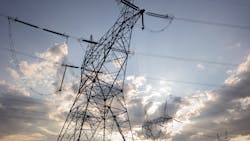With the recent signing of the Infrastructure Investment and Jobs Act, the utility industry is entering a new era of innovation that will prepare America’s infrastructure for future energy needs and create better resiliency in the face of natural disasters.
It’s clear that much of our aging grid is taxed and at its design limits. Earlier this year, more than 4.5 million homes and businesses lost power — some for several days from an ice storm that hit Texas — resulting in massive community loss and widespread financial consequences. The same held true when temperatures soared in the Northwest and the power grid failed, impacting thousands. Unfortunately, this is just a taste of what will happen more frequently if we don’t take decisive and urgent action.
The Infrastructure Investment and Jobs Act answers that call, funding grants and grid modernization programs that will enable the deployment of advanced technology solutions and enhanced energy management systems to harden the nation’s grid.
Accelerating Grid Modernization
Strengthening the grid is an extremely important piece of the puzzle when it comes to preparing for the risks and reducing the financial burden resulting from climate disruptions. The good news here is that we know what to fix and now how to fund the efforts. We can do more and go farther.
When it comes to funding these improvements, we need only look at the previous stimulus package (from 2009), which featured a Smart Grid Investment Grant (SGIG) program run by the Department of Energy that matched US$3.4 billion in federal funding with US$4.5 billion of industry investments. It did exactly what it was designed to do and was remarkably successful. That’s exactly why this program was re-funded by the Infrastructure Investment and Jobs Act, along with several new grant programs.
With the prior stimulus package, more than 200 electric utilities and providers participated in the SGIG program, submitting proposals for resiliency upgrades to their transmission and distribution networks, metering infrastructure and customer systems. By matching ratepayer investments with taxpayer investments, the grants set off a wave of grid modernization. This made America’s electric infrastructure safer and more efficient. The results were quantifiable and impressive. The Electric Power Board of Chattanooga, for example, was able to restore power 36 hours faster with SGIG investments after a 2014 windstorm. Without the upgrades, 37,000 customers would have been in the dark.
We will see similar benefits with the Infrastructure Investment and Jobs Act, which will fund grid modernization programs for advanced technology deployments and enhanced energy management systems for greater resiliency and reliability across the grid.
More Intelligence and More Possibilities
This new legislation will accelerate innovation and grid modernization, allowing utilities to deploy industrial IoT-enabled edge devices that communicate, coordinate and control equipment across the distribution network in real time. Utilities will be able to integrate their metering data with advanced weather forecasts and sensors in the field to better pinpoint and prevent storm-related outages. And the list goes on.
When smart grid systems are installed across the grid, they are self-healing. Smart meters can send out messages from the edge of the grid before losing power, speeding shutoffs and repairs during extreme weather events. Pole tilt sensors tell the utility that a tower is at risk of falling before it hits the ground and starts a fire. Fault location, isolation, and service restoration (FLISR) technologies can restore power in seconds by automatically detecting a feeder outage and switching customers to backup lines.
These upgrades will also help accelerate the adoption of the integration of renewables and electric vehicles (EVs). While renewables and EVs are stressors on the network, they are also an important step forward in lowering emissions and creating a more sustainable future. But they realize their full potential, the grid must be able to support them cost effectively and in real time.
Recouping Investments
Any new technology implementation will cause some to question whether the benefit outweighs the cost. However, studies have shown upgrades are many times cheaper than repairs. A study authorized by FEMA found that every US$1 invested in disaster mitigation or hardening avoids US$6 in rebuilding costs.
For example, Florida Power and Light used SGIG grants to install new transformer monitors. A single monitor detected a faulty transformer, preventing an outage for 15,000 customers and avoiding US$1 million in restoration costs.
In the case of the Texas ice storm, it is estimated that damages were more than US$20 billion. One study conducted after the 2011 power outage in Texas found that at the high end, winterizing 50,000 gas wells would cost an estimated US$1.75 billion. This of course never happened. US$1.75 billion was to fix one part of the problem — and might have seemed like a lot at the time — but it would have been a lot less expensive than the resulting damages from the 2021 storm. And with extreme weather incidences occurring at unprecedented rates — if proper upgrades are not made, it seems unlikely that we will make it another 10 years before another catastrophic grid failure takes place.
Creating a More Resourceful Future
The Infrastructure Investment and Jobs Act will usher the utility industry into the next era of grid modernization with access to additional federal funding needed to upgrade America’s infrastructure. It will give utilities the support they need to create resilient grid infrastructure — in the face of natural disasters and growing energy demand — that can enrich American’s lives while achieving a more resourceful and sustainable world.
Tom Deitrich is the president and CEO of Itron, which is innovating the way utilities and cities manage energy and water.
About the Author
Tom Deitrich
Tom Deitrich is the president and CEO of Itron, which is innovating the way utilities and cities manage energy and water.
